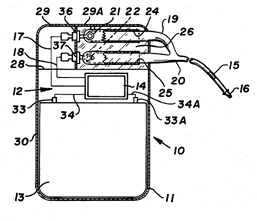Anthony Adducci
Editor-In-Chief: C. Michael Gibson, M.S., M.D. [1]
Anthony J. Adducci (August 14 1937 – September 19, 2006) was a pioneer of the medical device industry in Minnesota. He is best known for co-founding Guidant Corp. precursor Cardiac Pacemakers, inc., the company that manufactured the worlds first lithium battery powered artificial pacemaker.
Early life
Anthony J. Adducci was born in Chicago, Illinois on August 14th, 1937. He was married to Sandra Gordon, had 3 children Michael, Brian, and Alicia. He attended Saint Mary's University of Minnesota receiving the BS degree in Physics in 1959. He did additional study in electrical engineering at Illinois Institute of Technology Chicago, Illinois and in business administration at the University of Minnesota.
In 1960, he was employed as an acoustical engineer for the Jensen Manufacturing Company in Chicago, Illinois where he engaged in the design and development of loudspeakers and horns.
In 1961, he joined International Telephone and Telegraph Corporation in Chicago Illinois where, as a development engineer, he instructed numerous training courses on digital data communication systems and as a senior test engineer directed ITT personnel in electro-interference testing of the Boeing Minuteman (missile).
While in Chicago, Mr. Adducci worked with a local physician developing an electronic ear thermometer used to detect the time of ovulation in the human female.
In August of 1964, he accepted a position with the Sperry Rand Corporation's UNIVAC Division in St. Paul Minnesota as a system design engineer engaged in the logic design of computer peripheral equipment.
In April of 1966, he joined Medtronic as a Sales Engineer. While at Medtronic he served in various technical and marking responsibilities including, sales administration manager, and pacemaker consulting specialist.
In February of 1972, he co-founded Cardiac Pacemakers Inc. (CPI) of St. Paul, Minnesota. CPI was a highly successful start up venture, going from zero sales in 1972 to over $47 million and highly profitable when it was acquired by Eli Lilly and Company in 1978 for $127 million.
Board of Directors
- Catholic Charities of the Archdiocese of St. Paul/Minneapolis
- Trustee of Saint Mary's University of Minnesota.
- Development Committee of the North American College of Rome
- Health Advisory Council of the College of St. Catherine in St. Paul, Minnesota
- Deltec in Arden Hills (founding director)
- Medical Graphics in Vandais Heights (founding director)
- Dimensional Medicine in Minnetonka (founding director)
- Delphax in Minnetonka (founding director)
- CAPSULE design in Minneapolis (founding director)
- North American Banking Companies (founding director)
Charity
Mr. Adducci founded The Adducci Family Foundation. A Charitable foundation with special interest in child abuse, battered woman and special educational programs for the elderly.
Honors

- Knight Grand Cross of the Order of the Holy Sepulchre of Jerusalem
- Knight in the Order of Multa.
- 3rd degree black belt in Tae Kwon Do Karate
- 2nd degree black belt in Aikido and founder of the Minnesota Ki Society.
Publications
- "Transient Distortion in Loudspeakers" 1961 May-June, Issue IRE Tansactions on Audio, Volume AU-9, Number 3, pp. 79-85, 1961 IRE International Convention Record.
- "Ovulation Detection by Internal Cranial Temperature Measurements", January, 1965, Issue IEEE Transactions on Bio-Medical Engineering, Volume BME-12, Number 1, pp. 2-7.
- "Special Electrical Considerations in the Intensive Coronary Care Unit", 1970 September Issue, The Journal of Extra-Corporeal Technology.
Held Patents

- PT#: 3822707 Metal-Enclosed Cardiac Pacer with Solid-State Power Source - Image Document
- PT#: 3822707 Metal-Enclosed Cardiac Pacer with Solid-State Power Source - Text Document
An improved heart pacer including the conventional combination of a pulse generator, electrode means, and electrode leads coupling the pulse generator to the electrodes, wherein the battery power source of the pulse generator is a solid-state battery with a lithium anode and a lithium-iodide electrolyte.(see Wilson Greatbatch, ed.). The pacer structure is enclosed in a hermetically sealed metallic enclosure, with means being provided in the enclosure for passing electrode leads in sealed relationship therethrough. The outer surface of the casing is polished metal*, and is continuous in all areas. In certain instances, the continuity may be with the exception of the zone through which the external electrode leads pass.
*In the patent claim the term polished metal * was used as an all-encompassing description. The initial commercial artificial pacemaker, under the patent in 1972, used stainless steel as a non-hermetic encasing medium. Continuing research led to use of the more biologically compatible titanium in a welded hermetically sealed pacemaker in 1976.
External Links